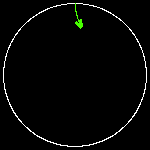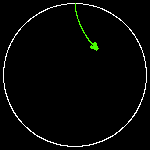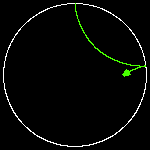


If we follow where a sound wave goes, starting from the surface, it first moves into the Sun almost straight towards the centre. Its path then slowly bends around, because of the increasing sound speed, so that it misses the centre of the Sun. How exactly it moves therefore depends on the details of the sound speed inside the Sun. The point of closest approach is known as the turning point of the mode. After the turning point the wave moves out again until it reaches the surface. At the surface it is reflected as if by a mirror and it goes back in again.
Here are a few examples of how sound waves propagate into the Sun, with some animated sequences.
These sound waves give rise to so-called standing waves, in the same way that a vibrating string shows standing waves. In the Sun we are talking about standing waves in three dimensions of course. Here we show some examples of how the waves look on the solar surface (the amplitude is very much enhanced).



This page contains more information about oscillations on the solar surface.
The oscillation pattern on the surface can be characterised by node lines, on which the motion vanishes. The total number of node lines is called the degree l. The oscillation modes can also have node lines at constant longitude. There are a number m of those which is always less than or equal to the degree l. Inside the Sun the amplitude of the standing waves can have a number n, called the radial order of the mode, of nodes at certain radii from the centre.
If we know these three number n, l, and m we know exactly what mode it is we are looking at. If two modes have different n or l this means that the paths they follow in the Sun are slightly different. Since these modes have different frequencies that means that the sound speed along the path that one mode followed is different from the sound speed along the path of the other mode. This means we can measure the difference in sound speed between the two paths. If we have very many modes we can, by carefully analysing which mode went through which part of the Sun, determine what the sound speed is in every part of the Sun that the sound waves passed through -- with this we can build up a very detailed picture of the physical conditions in the solar interior. To get to that point we use various inversion techniques which are very similar to those used in geophysics for geoseismic research based on analysis of data on earthquakes.